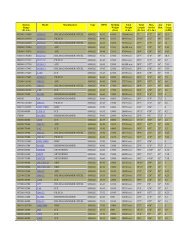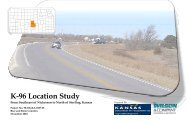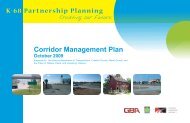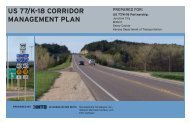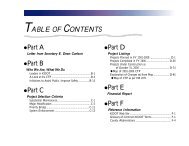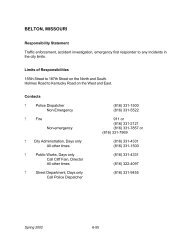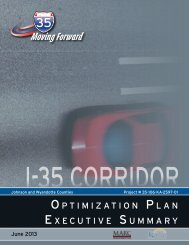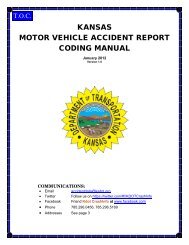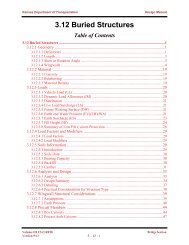Full Plan - Kansas Department of Transportation
Full Plan - Kansas Department of Transportation
Full Plan - Kansas Department of Transportation
You also want an ePaper? Increase the reach of your titles
YUMPU automatically turns print PDFs into web optimized ePapers that Google loves.
an indirect impact on ITS. The T2000 plan was presented to the House and was not<br />
voted on due to discussion on funding methods <strong>of</strong> a new transportation program.<br />
HB2071<br />
On Friday April 30, 1999 the <strong>Kansas</strong> Legislature passed and on May 10, 1999 the<br />
Governor signed a $12.6 billion transportation plan. The enacted Comprehensive<br />
<strong>Transportation</strong> Program focuses on the ten-year period from FY 2000 through FY 2009.<br />
The bill has four sections. The first section is the State Highway System which includes<br />
expenditures to improve and maintain the State Highway System (maintenance, major<br />
modifications, system enhancements, demonstration projects, minimum expenditure per<br />
county, and noise abatement program). The second section assists local governments<br />
with roads and bridges not on the State Highway System. The third section assists modal<br />
partnerships such as railroad service, aviation, and public transit. The forth section<br />
outlines the annual reporting requirements.<br />
This Comprehensive <strong>Transportation</strong> Program provides additional funding <strong>of</strong> $2.3 billion<br />
in the FY 2000 through FY 2009 from motor fuel tax, bond proceeds, and the sales tax<br />
transfer. This bill does not increase motor vehicle registration fees or the state sales tax.<br />
1.1.6 KDOT Internet/Intranet Strategic Direction Study<br />
In October 1997 the KDOT Internet/Intranet Strategic Direction Study was completed.<br />
This report provided recommendations for how KDOT could achieve the most effective<br />
Internet/Intranet strategy. The project encompassed a thorough review and evaluation <strong>of</strong><br />
relevant KDOT documents and reports, current KDOT Internet/Intranet initiatives,<br />
interviews with KDOT staff, and joint application development meetings. The two major<br />
KDOT documents that were used as sources <strong>of</strong> input for the study were the Records and<br />
Workflow Management Report (1996) and the KDOT Information Technology<br />
Architecture <strong>Plan</strong> (1996).<br />
The KDOT Internet/Intranet Strategic Direction Study addresses a number <strong>of</strong> topics<br />
including Internet and Intranet project management, technologies to be implemented such<br />
as Internet/Intranet s<strong>of</strong>tware and web server hardware, network security issues, web site<br />
hosting options and a recommended implementation plan. The benefits <strong>of</strong> this<br />
Internet/Intranet strategy include reduction in s<strong>of</strong>tware maintenance costs, wider access<br />
to KDOT data and applications across all <strong>of</strong> KDOT’s business units, and enhanced<br />
communication with customers and employees.<br />
This study has a significant impact on the Statewide ITS <strong>Plan</strong> in that the KDOT Internet<br />
and Intranet web sites will be an important medium for sharing ITS-related information.<br />
For instance, advanced traveler information such as planned construction projects, road<br />
closures, weather forecasts and road conditions will be made available to travelers via the<br />
KDOT Internet web site. Also, detailed RWIS information will be shared internally<br />
throughout KDOT via the KDOT Intranet. Thus, the KDOT Internet/Intranet Strategic<br />
Baseline Condition Report 1-9<br />
Section 1 <strong>of</strong> the <strong>Kansas</strong> Statewide ITS <strong>Plan</strong><br />
July, 00



